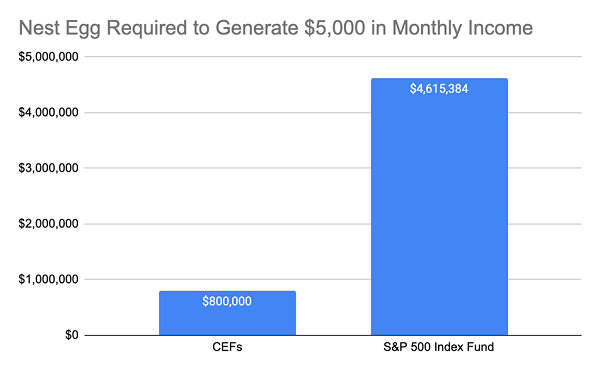I always have a good laugh when the press talks about our favorite high-yield plays—closed-end funds (CEFs)—like they’re some new thing! Of course, we seasoned CEF investors have long known that these funds, which pay out average dividend yields of 7.5%, are the key to retiring on dividends alone.
(The 20 CEFs in our CEF Insider service’s portfolio do even better than that, yielding 8% as I write this, with the highest payer of the bunch paying a life-changing 9.8%.)
Nonetheless, the media continues to be floored by this news!
The latest occurrence came on February 9, when CNBC ran an article called “Retirees Seeking Income May Want to Consider Closed-End Funds.” The piece pointed out that the over 500 CEFs in existence “could be one piece of the puzzle” for investors looking to generate income since they “can provide decent yields.”
Decent yields!? I don’t know about you, but I think a 7.5% dividend (with many CEFs paying every month, to boot) is better than “decent”!
Media Spotlight Will Draw More Attention to CEFs
Nonetheless, to see our favorite income plays profiled on a major outlet like CNBC is rare indeed—and it’s likely to lead to even more attention as investors continue to hunt for safe, steady yields that outpace those of Treasuries and CDs, even with rising interest rates.
After all, a 7.5% yield can help you retire much more easily than the 1.3% you’d get from an S&P 500 index fund. And you likely wouldn’t even have to change investments, because many CEFs hold the same exact blue-chip stocks most people own anyway!
With a 7.5% payout, if you want a $5,000 income stream flowing your way, you’d only need to put $800,000 into CEFs. That same income stream would cost you over $4.6 million with an index fund.

Source: CEF Insider
With a typical CEF requiring a fifth of the capital to retire on dividends as you’d need from the benchmark ETF, it’s no wonder why the press is finally taking a serious look at CEFs.
In addition, thanks to the recent pullback, CEFs’ discounts have widened a bit. Right now, for example, the average CEF discount to net asset value (NAV, or what the CEF’s portfolio holdings are worth) stands at 4.7%—just a year ago, that discount was much smaller: just 1%. That, along with the increased attention CEFs are getting, gives us a nice window to buy in.
The media’s recent epiphany is even better for members of my CEF Insider service because we’ve already bought at attractive valuations, and as the market for CEFs grows, we’ll have more interested buyers keen to take them off our hands for a tidy profit.
The Power of the Disappearing Discount
To see this in action, let me take you back to a little less than three years ago, when I spotted an overlooked opportunity in the Liberty All-Star Growth Fund (ASG) and shared it with you in an article on Contrarian Outlook. Back then, ASG offered a 9.5% dividend yield and traded at a 7.8% discount to NAV.
The fund holds a mix of mid- and large-cap growth stocks; its top-10 holdings currently include Visa (V), Amazon.com (AMZN) and UnitedHealth Group (UNH), as well as lesser-known companies like property manager FirstService (FSV).
Two things have happened to this fund; first of all, its fat discount has shrunk to just 1.3% today, which acts like a catapult on its market price, propelling it higher as the discount dwindles. The end result is a 71% total return in less than three years (including dividends). That just isn’t supposed to happen with a high-yielder like this, but with CEFs, it happens all the time.
Not just that, but the fund’s dividend has grown by over 25% since then. The end result is that investors who bought ASG then and are still holding are enjoying a 16% yield on their original buy, thanks to those payout hikes over the years.
It’s great that the mainstream press is starting to see just how valuable CEFs are, because it means the story of ASG is about to repeat with other funds.
And with ASG’s discount almost completely gone, buyers now have ample selling opportunities after getting this fund for much less than its assets are truly worth. These closing discounts to NAV, which are unique to CEFs, are how we use these funds to pick up strong capital gains while also enjoying a big income stream along the way.
4 Cheap 7.5% Dividends to “Front Run” the Crowd Into CEFs
Enough about the past—let’s pinpoint the exact CEFs we need to buy to grab big, discount-driven gains (and big dividends, too!) in the next few months as more investors flock to CEFs.
I’ve got four picks waiting for you that are sitting right in the tracks of this stampede! Plus, they trade at such deep discounts now that they’re primed for fast 20%+ price upside as their discounts shrink (and flip to premiums), taking their market prices along for the ride!
AND you’ll be pocketing these funds’ rich 7.5% average dividends as you watch your share prices rise. The kicker? All four of these undervalued income plays send dividend cash your way monthly!
Don’t miss your chance to buy while you can still do so for cheap. Click here and I’ll give you full details on these 4 urgent CEF buys. You’ll get their names, tickers, current yields, discounts and everything else you need to know.

Recent Comments